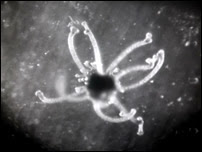
Un adolescente no tiene mucho de que hablar más que de sí mismo. En este caso, Sadie Benning habla sobre su despertar sexual.
“I don’t talk, I’m not physically in it, it’s all hand written text, music; I wanted to substitute objects, things that were around me, to illustrate the events. I used objects in the closest proximity – the television, toys, my dog, whatever”
Benning habla, por lo general desde su cuarto. En Jollies, utiliza muchas metáforas. Me encanta cuando hace el ritual de afeitarse. Muñecas, papelitos, etc. Haciendo algo así como un collage.

"Un momento vital que, de acuerdo con muchas teóricas, es fundamental en la escritura autobiográfica gay o lésbica constituyéndose como el eje en torno al que pivota el relato de la propia vida, puesto que como apunta Kath Weston, “en este momento histórico, la identidad lésbica o gay se materializa de igual forma en el decir, como en el sentir o en el hacer” (2). El sentimiento de ser rara o queer se concreta en un tríptico en que las emociones se tensan y oscilan entre la angustia, el deseo, la autoafirmación y el desprecio hacia los otros. "

Estuvo dos años en Le Tigre, definido como "electroclash." Benning estuvo del 1998 hasta el 2001.
Formado por Kathleen Hanna (Bikini Kill) y Johanna Fateman. Hanna, sacó un proyecto alterno llamado Julie Ruin, aquí un video dirigido por Benning.
“When I was a kid I took my shirt off imagining I was just as sexy and powerful as when Matt Dillon did it for the centerfold of Teenbeat magazine.”
“I rode my big wheel down the street pretending I was Erik Estrada riding on my motorcycle to save the life of some girl who desperately needed to be rescued.”
“It's only been a year ago that I crawled the walls. You know, I've been waiting for that day to come when I could walk the streets and people would look at me and say that's a DYKE. And if they didn't like it they'd fall into the center of the earth and deal with themselves. Maybe they'd return but they'd respect me.”

Benning's childhood fantasies reverse the conventional images and play of young girls who are encouraged to dream of rescue by the handsome prince. These fantasies extend beyond role reversal and appropriation when she also includes her emulation of female rock stars including Joan Jett, Debbie Harry of Blondie, and the Go-Go's, early media icons of powerful, independent women. The images of women in popular culture began to change in the 1980s, providing teenage girls with figures of their own, rather than those independently appropriated from male images of power and autonomy.
Theorist Catherine Russell, in Experimental Ethnography: the Work of Film in the Age of Video, elaborates a historiography for the video diary containing artists like George Kuchar, Jonas Menkas, and Sadie Benning. While the video diary stands as a testimonial form, Russell is quick to assert the performativity of video diary, arguing that the identity constructed for the viewer is not necessarily an authentic identity. She writes that in the video diary “documentary truth is mixed freely with storytelling and performances” (278). The video diary “is a vehicle and a strategy for challenging imposed forms of identity and exploring the discursive possibilities of inauthentic subjectivities” (276). In other words, the form allows for a personalized construction of one’s identity that evades the compulsion toward authenticity and that might instead function as a mode of cultural critique.

"Su cuerpo, de acuerdo con las teorías de Judith Butler, se convierte en ambas en un proceso activo de encarnación de ciertas posibilidades culturales e históricas. Apropiación y subversión. "
http://archive.sensesofcinema.com/contents/directors/03/benning.html
http://en.wikipedia.org/wiki/Sadie_Benning
http://www1.hollins.edu/classes/dance/website/newmediaweb/jennygfolder/sadiebenning.html
http://www.nytimes.com/1993/03/28/arts/up-and-coming-sadie-benning-a-video-artist-who-talks-through-a-keyhole.html
http://www.thefilmjournal.com/issue4/sadiebenning.html



No hay comentarios:
Publicar un comentario